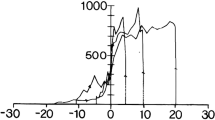Abstract
A variety of different types of instability has been found in the saccadic system of humans. Some of the instabilities correspond to clinical conditions, whereas others are inherent in the normal saccadic system. How can these instabilities arise within the mechanism of normal saccadic eye movements? A physiologically-based model of the saccadic system predicts that horizontal saccadic oscillations will occur with excessive mutual inhibition between the left and right burst cells and with underaction of the pause cells. The amplitudes and frequencies of the oscillations had ranges of 0–6° and 6–20 cycles per second, respectively. Application of stability analysis techniques to the model reveals that development of the oscillations can be explained by the Hopf bifurcation mechanism. Future development of this approach will involve classifying pathological instabilities of the saccadic system according to the bifurcation involved in their generation.
Similar content being viewed by others
References
Abadi RV, Gowen E (2004) Characteristics of saccadic intrusions. Vis Res 44:2675–2690
Akman OE, Broomhead DS, Abadi RV, Clement RA (2005) Eye movement instabilities and congenital nystagmus can be predicted by a nonlinear model of the saccadic system. J Math Biol 51661–694 (2005)
Ashe J, Hain TC, Zee DS, Schatz NJ (1991) Microsaccadic flutter. Brain 114:461–472
Bahill AT, Clark MR, Stark L (1975) The main sequence, a tool for studying human eye movements. Math Biosci 24:191–204
Broomhead DS, Clement RA, Muldoon MR, Whittle JP, Scallan C, Abadi RV (2000) Modelling of congenital nystagmus waveforms produced by saccadic system abnormalities. Biol Cybern 82:391–399
Carpenter RHS (1988) Movements of the eyes, 2nd Edn. Pion Limited, London p 70–72
Gancarz G, Grossberg G (1998) A neural model of the saccade generator in the reticular formation. Neural Netw 11:1159–1174
Lebedev S, Gelder PV, Tsui WH (1996) Square-root relations between main saccadic parameters. Invest Ophthalmol Vis Sci 37:2751–2758
Leigh RJ, Zee DS (1999) The neurology of eye movements, 3rd edn. Oxford University Press, Oxford, pp 91–92
Optican LM, Zee DS (1984) A hypothetical explanation of congenital nystagmus. Biol Cybern 70:291–302
Ramat SJ, Leigh J, Zee DS, Optican LM (2005) Ocular oscillations generated by coupling of brainstem excitatory and inhibitory saccadic burst neurons. Exp Brain Res 160:89–106
Scudder CA, Kaneko CRS, Fuchs AF (2002) The brainstem burst generator for saccadic eye movements. A modern synthesis. Exp Brain Res 142:439–462
Sparks DL (2002) The brainstem control of saccadic eye movements. Nat Neurosci Rev 3:952–964
Van Gisbergen JAM, Robinson DA, Gielen S (1981) A quantitative analysis of generation of saccadic eye movements by burst neurons. J Neurophysiol 45:417–442
Verdaasdonk BW, Koopman HFJM, van Gils SA, van der Helm CT (2004) Bifurcation and stability analysis in musculoskeletal systems: a study in human stance. Biol Cybern 91:48–62
Wilson HR (1999) Spikes, decisions and actions. The dynamical foundations of neuroscience. Oxford University Press, Oxford, p 126
Zee DS, Robinson DA (1979) A hypothetical explanation of saccadic oscillations. Ann Neurol 5:405–414
Author information
Authors and Affiliations
Corresponding author
Rights and permissions
About this article
Cite this article
Laptev, D., Akman, O.E. & Clement, R.A. Stability of the saccadic oculomotor system. Biol Cybern 95, 281–287 (2006). https://doi.org/10.1007/s00422-006-0087-3
Received:
Accepted:
Published:
Issue Date:
DOI: https://doi.org/10.1007/s00422-006-0087-3




